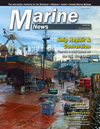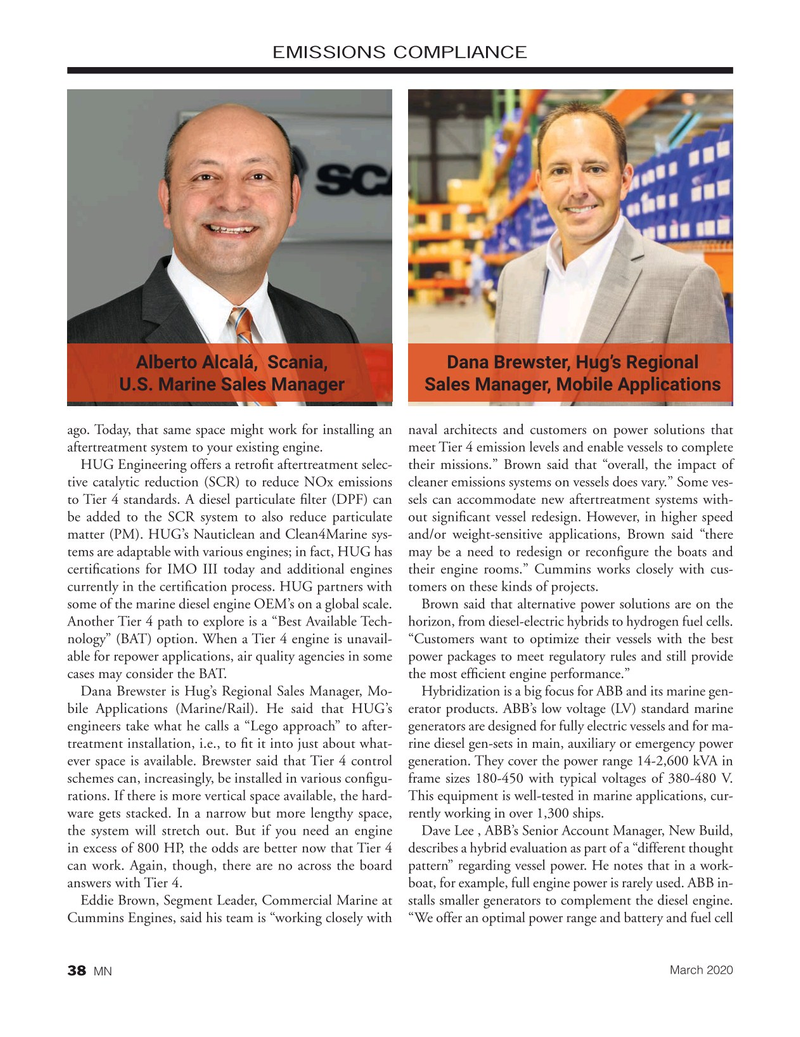
Page 38: of Marine News Magazine (March 2020)
Workboat Conversion & Repair
Read this page in Pdf, Flash or Html5 edition of March 2020 Marine News Magazine
EMISSIONS COMPLIANCE
Alberto Alcalá, Scania, Dana Brewster, Hug’s Regional
U.S. Marine Sales Manager Sales Manager, Mobile Applications ago. Today, that same space might work for installing an naval architects and customers on power solutions that aftertreatment system to your existing engine. meet Tier 4 emission levels and enable vessels to complete
HUG Engineering offers a retro? t aftertreatment selec- their missions.” Brown said that “overall, the impact of tive catalytic reduction (SCR) to reduce NOx emissions cleaner emissions systems on vessels does vary.” Some ves- to Tier 4 standards. A diesel particulate ? lter (DPF) can sels can accommodate new aftertreatment systems with- be added to the SCR system to also reduce particulate out signi? cant vessel redesign. However, in higher speed matter (PM). HUG’s Nauticlean and Clean4Marine sys- and/or weight-sensitive applications, Brown said “there tems are adaptable with various engines; in fact, HUG has may be a need to redesign or recon? gure the boats and certi? cations for IMO III today and additional engines their engine rooms.” Cummins works closely with cus- currently in the certi? cation process. HUG partners with tomers on these kinds of projects.
some of the marine diesel engine OEM’s on a global scale. Brown said that alternative power solutions are on the
Another Tier 4 path to explore is a “Best Available Tech- horizon, from diesel-electric hybrids to hydrogen fuel cells. nology” (BAT) option. When a Tier 4 engine is unavail- “Customers want to optimize their vessels with the best able for repower applications, air quality agencies in some power packages to meet regulatory rules and still provide cases may consider the BAT. the most ef? cient engine performance.”
Dana Brewster is Hug’s Regional Sales Manager, Mo- Hybridization is a big focus for ABB and its marine gen- bile Applications (Marine/Rail). He said that HUG’s erator products. ABB’s low voltage (LV) standard marine engineers take what he calls a “Lego approach” to after- generators are designed for fully electric vessels and for ma- treatment installation, i.e., to ? t it into just about what- rine diesel gen-sets in main, auxiliary or emergency power ever space is available. Brewster said that Tier 4 control generation. They cover the power range 14-2,600 kVA in schemes can, increasingly, be installed in various con? gu- frame sizes 180-450 with typical voltages of 380-480 V. rations. If there is more vertical space available, the hard- This equipment is well-tested in marine applications, cur- ware gets stacked. In a narrow but more lengthy space, rently working in over 1,300 ships. the system will stretch out. But if you need an engine Dave Lee , ABB’s Senior Account Manager, New Build, in excess of 800 HP, the odds are better now that Tier 4 describes a hybrid evaluation as part of a “different thought can work. Again, though, there are no across the board pattern” regarding vessel power. He notes that in a work- answers with Tier 4. boat, for example, full engine power is rarely used. ABB in-
Eddie Brown, Segment Leader, Commercial Marine at stalls smaller generators to complement the diesel engine.
Cummins Engines, said his team is “working closely with “We offer an optimal power range and battery and fuel cell
March 2020 38 MN

 37
37

 39
39
